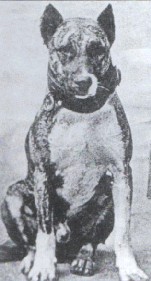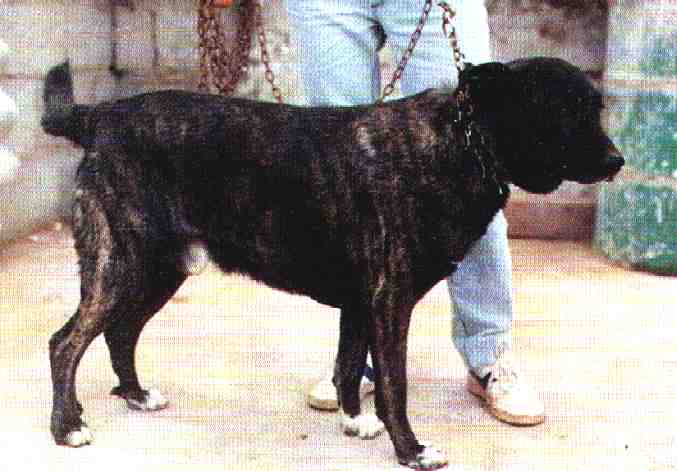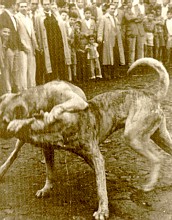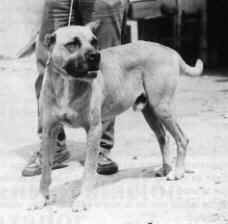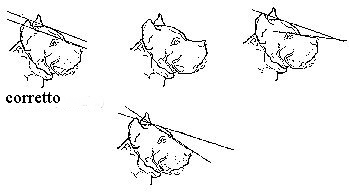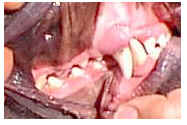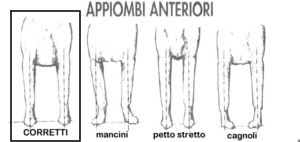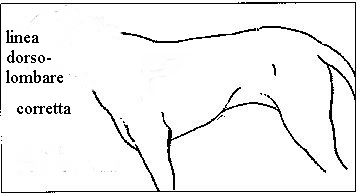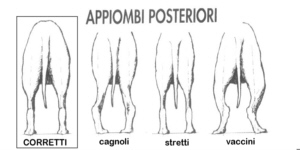CANARY ISLANDS MASTIFF
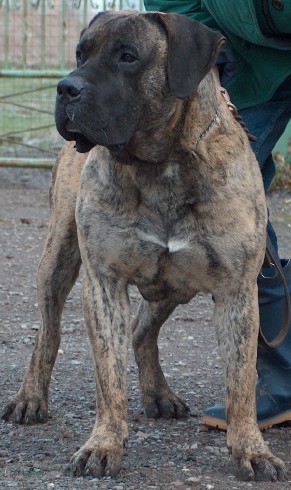
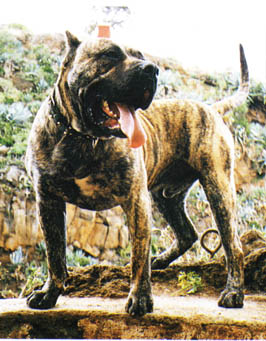
In the photos 2 beautifulst subjects of Luigi Gianfrotta ( www.dogo-canario.org )
FCI-Standard N° 346 / 03. 10. 2007
TRANSLATION: Revised by Jennifer Mulholland in collaboration with Renée Sporre Willes and Jorge Nallem.
ORIGIN : Spain.
DATE OF PUBLICATION OF THE ORIGINAL VALID STANDARD : 04.06.2001.
UTILIZATION : Guard dog used for protection of cattle.
CLASSIFICATION F.C.I. : Group 2 Pinscher and Schnauzer - Molossoid breeds - Swiss Mountain and Cattle dogs. Section 2.1 Molossoid:Mastiff type Without working trial.
SUGGESTED BREEDINGS by MENANDPETS.COM:
No breeding to signal
if you want to know like signaling yours, contacts: marketing@inseparabile.it
BRIEF HISTORICAL SUMMARY
A molossoid type dog, originating from Tenerife and Gran Canaria (Canary Islands). It appears to be the result of matings between the "majorero", a prehispanic dog indigenous to these islands, and other molossoids introduced to the Canary Islands.These matings produced an ethnical group of mastiff-type dogs, of medium size, brindle or fawn with white marking, with a specific molossoid morphology but yet agile and powerful, having a strong temperament, robust and lively, loyal character. During the XVI and XVII centuries, the number of these dogs increased considerably and numerous references to them in pre-Conquest historical texts, especially in the "Cedularios del Cabildo" (municipal registers), which explain their duties essentially as guard dogs and protectors of cattle.
GENERAL APPEARANCE
A medium sized molossoid, with a rectilinear profile and black mask. Robust and well-proportioned. The body is longer than the height at the withers; this characteristic is more noticeable in the female.BEHAVIOUR / TEMPERAMENT
Calm appearance; attentive expression. Especially suited to guarding and traditionally used for herding cattle. Balanced temperament and very self-confident. Low and deep bark. Obedient and docile with family members, very devoted to its master, but is suspicious of strangers. Confident attitude, noble and a little distant. When alert, the stance is firm with a vigilant attitude.HEAD
Massive, brachycephalic and compact in appearance, covered with supple, loose skin. The shape tends towards a slightly elongated cube.Skull-foreface proportion is 60-40%. The width of the skull is 3/5 of the total length of the head.
CRANIAL REGION
Skull : Slightly convex in anteposterior and transversal direction. Frontal bone tends to be flat. The width is almost identical to the length. Pronounced zygomatic arch, with well developed cheek and jaw muscles, but not prominent. The occipital protuberance is only slightly marked.
Stop : The stop is pronounced, but not abrupt. The furrow between the frontal lobes is well defined and is about two thirds the size of the skull. The cranial-facial lines are parallel or slightly converging.
FACIAL REGION :
Nose :Wide, strong black pigmentation.. In line with the muzzle. The upper part is placed slightly GO BACK TO LIST beginning of the flews. The nostrils are large to facilitate breathing.
Muzzle : Shorter than the skull, normally about 40% of the total length of the head. The width is 2/3 of that of the skull. Very wide base, narrowing slightly towards the nose. Bridge of the nose is flat and straight, without ridges.
Lips: The upper lip is pendulous, although not excessively. Seen from the front, the upper and lower lips come together to form an inverted V. The flews are slightly divergent. The inside of the lips is a dark colour.
Jaw/Teeth : Scissor-bite. Pincer-bite is admitted but not desirable due to the dental erosion produced. Slightly undershot is accepted. The dental arch is wide at the canines. The teeth are wide and solidly set. Large molars, small incisors, well developed canines..
Eyes : Slightly oval in shape, from medium to large in size. Set well apart, but neither sunken nor protruding. Eyelids are black and tight-fitting, never sagging. The colour varies from dark to medium brown, depending on the colour of the coat. They should never be light.
Ears : Medium sized, set well apart, with short and fine hair. They fall naturally on each side of the head. If folded, they do so in the shape of a rose. They are set on slightly above eye level. Ears set too high and very close on the head are considered unusual. In countries were cropping is allowed, they must stand erect.
NECK
Shorter than the length of the head. Skin on the underside is loose, forming a slight dewlap. Solid and straight, it tends to be cylindrical and muscular.BODY
Long, broad and deep, it is 18 to 20% longer than the height at the withers; this aspect is more pronounced in females. The flanks are only slightly pronounced.Topline: Straight, without deformations and sustained by well developed but barely visible muscles. Rising slightly from the withers to the croup. Saddle or roach backs are unacceptable.
Croup: Medium, broad and rounded. Should not be long as this would limit movement. The female is usually broader.
Chest: With great capacity and well defined pectoral muscles. Seen from both the front and the side, it should be well let down to at least the elbow. Thoracic perimeter is usually equal to the height at the withers plus 45%. Well sprung ribcage.
Underline : Slightly tucked up, never sagging.
TAIL
Thick base, tapering to the tip, down to the hock but no longer. Medium set on. In action it rises like a sabre, but without curling nor leaning towards the back. At rest it hangs straight with a slight curve at the tip.LIMBS
FOREQUARTERS :Shoulders: Well laid back.
Upper arms : Well angulated, oblique with forearms well balanced, straight. Strong boned and well muscled.
Elbows : Must be neither too close to the ribs nor sticking out. The distance from elbow to ground should be 50% of the height at the withers for males and a little less for females.
Metacarpus (Pasterns): Very solid and slightly sloping.
Feet : Cat feet with rounded toes, not too close together. Well developed and black pads. Nails are dark, white nails should be avoided, although they can occur in function of coat colour.
HINDQUARTERS : Strong and parallel, without deviation.
Upper Thigh: Long and well muscled thighs. Angulation not very pronounced but should not be insufficient.
Hocks : Always well let down.
Hind feet: Slightly longer than the front feet, otherwise identical.
GAIT / MOVEMENT
On the move, the Dogo Canario is agile and supple and should cover a lot of ground. Long reach. The tail is carried low and the head is carried only a little above the level of the back. When alert, the head and tail are carried high.SKIN
Thick and elastic. Loose on and around the neck. When alert, the skin on the head forms symmetrical wrinkles which fan out from the furrow between the front lobes.COAT
HAIR : : Short, coarse, flat with no undercoat (it can appear in neck and GO BACK TO LIST the thighs). Rather coarse to the touch. Very short and fine in the ears, slightly longer on the withers and on the back of thighs.COLOUR : All shades of brindle, from warm dark brown to pale grey or blond. All shades of fawn to sandy. White marks are acceptable on the chest, at the base of the neck or throat, forefeet and toes of hind feet, but these should be kept to a minimum.
The mask is always black, and should not spread above eyelevel.
SIZE AND WEIGHT
Height at the withers : Males : 60 to 65 cm. - Females: 56 to 61 cm.For very typical specimens, a tolerance of 1 cm. over or under these limits is accepted. Weight: Minimum: Males: 50 kg. - Females: 40 kg.
FAULTS
Any departure from the foregoing points should be considered a fault and the seriousness with which the fault should be regarded should be in exact proportion to its degree.
- Too many facial wrinkles, but not affecting the expression.
- Pincer bite.
SEVERE FAULTS
- Incorrect head-face proportions
- Extremely convergent facial-cranial lines (over pronounced stop)
- Extremely divergent facial-cranial lines.
- Excessive mask (above the level of eyes)
- Feet and toes turning outwards or inwards
- Excessively pendulous, small or prominent flews.
- Loins and withers of the same height.
- Too large dewlap
- Sagging eyelids
- Bridge of nose not flat.
- Excessive or poor angulations.
- Sagging underline.
- Chest not deep enough.
- Incorrect position of limbs.
- Thin tail. Set on too high.
- Insufficient amount of bone.
VERY SEVERE FAULTS
- Square profile.
- Triangular head, narrow (not cube shape)
- Weak appearance
- Curled tail, very thin, equally thick throughout its length; or deformed.
- Size outside the limits of the standard.
- Saddle or roached back.
- Narrow chest.
- Frail appearance, seen from the front..
- Insufficiently sprung ribcage.
- Absence of wrinkles on the facial-cranial area (skin taut, not elastic)
- Light eyes (yellow), very close together or oblique, sunken or protuding.
- Very undershot mouth.
- Missing teeth (except P1).
- Ears set very high.
- Rounded or domed skull.
- Smooth and thin hair
- Insufficient mask.
- Long neck, not thick enough.
ELIMINATING FAULTS
- Aggressive or overly shy.
- Unbalanced temperament.
- Depigmented nose or mouth lining.
- Total absence of mask.
- Unacceptable white marks.
- Overshot mouth.
- Croup lower than withers. Sloping topline.
- Blue eyes or unmatched in colour.
- Cropped tail.
- Monorchid or cryptorchid specimens.
- Lack of chest capacity.
Any dog clearly showing physical or behavioural abnormalities shall be disqualified.
N.B.: Male animals should have two apparently normal testicles fully descended into the scrotum.
Automatic translate from inseparabile.com
|
The HISTORY of the CANARIAN DOGO |
|
The "taken Canarian Dogo" a molosso from of medium ransom, original of the Islands of Tenerife and Canarian Gran, Spain. |
|
|
Nacque essentially as the result of crossings between "Bards" or "Majorero", dog oriundo of the island of Fuertaventura, descendant of the dogs aboriginals, with molosso and Alan from taken raised from the Spanish, conquerors of those islands in the XVI sec. |
|
|
Subsequently, with the English colonization of the XVIII sec. the practical one of the fight between dogs is diffused in the Islands. |
|
|
To leave from 1970, for, thanks to the job "parallel" of some gets passionate breeders of Tenerife, resolutions to you to avoid its passing and to create, with opportune crossings between breeds from taken and not, the "Canarian", modern Perro de Taken (Canarian Dogo). Today the considered race native cultural patrimony of the Islands Canarian. |
|
The CHARACTER of the CANARIAN DOGO
The characteristics of the Standard of the race indicate: ... particularly equipped like dog from guard and defense... its impetuous temperament, its aspect denotes power...
In realt the appearance of the Canarian Dogo calm; it has a trusting, noble expression, little distaccata. Its serene aspect, the careful look. And a particularly equipped molossoide for the guardiano function, and traditionally used for the management of the bovine cattle.
Its strong but balanced temperament; much sure one of s.
It has serious and deep latrato; docile and mansueto with its family, great attachment towards suspicious and mistrustful its landladies, while with the strangers.
Skillful lottatore, character who extension for atavism: in the years it passes to you, in the places dorigine in fact was often used like dog from combat, therefore permane in he one warlike spirit towards its similar ones, in particular if of the same sex.
Its exceptional temperament, the rusticit, the typical expression, is characteristics that the "Canarian Dogo" has inherited from its ancestors: the "Perro de ganado Majorero", dog from shepherdesses and excellent guardiano, much diffusing in the archipelago of the Islands Canarian.
As in order nearly all breeds the female has unindole devout sweet of the male, therefore he turns out devout gestibile easy; the male has a personalit strongly devout and perci he needs of wrist nelleducazione. Firmness, therefore, but also patience and dolcezza and never arranges too much violent and punished to you.
It is behaved friendly with the children but it does not love to be tormented and however it remains the fact that whichever stranger comes itself to find allinterno of the propriet entrusted to a Canarian Dogo, comes considered from questultimo an intruder to prescind dallet..
It does not have to expect the dog from branco from sguinzagliare to the garden or raising in group: the Canarian Dogo feels the dominanza of its landladies and expects from he exclusive attentions.
C$r-retired the head low capacity and the falling tail, to sabre shape; if the dog careful or excited the head high capacity and the tail raises itself to of over dellorizzontale.
It does not have to be forgotten moreover that it is found to us of forehead to a molosso that mature a lot slowly (speaks nearly three years for the males, unpo less for the females), that it needs of a coherent and disciplined training; once understood who the capobranco from a Canarian Dogo they are not had that satisfactions. Lequilibrio its force.
The master loves a lot and obeys to the commandos in order to make it content, dowries to take advantage of just in training.
|
STANDARD of the Canarian Dogo |
General aspect
Dog of medium ransom, from the profile straight. Of peasant aspect and very proporzionato. E' a mesomorfo the whose log of greater length regarding the Height. The females are usually devout longilinee.
Head massiccia, of square aspect and wide skull. The labbra advanced those inferiors cover. Strong mucosae of black color, teeth, very implant to you. Eyes of brown color, medium largeness. Orecchie with high insertion. Neck cylindrical, much muscoloso and covered with skin lassa, elastic. Light giogaia.
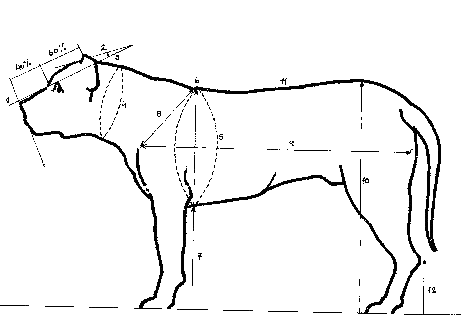
Short and straight shoulders. Attack of the high tail. Wide, wide chest. Ventre leggermente withdrawn, refolded. Front limbs from the perfect one perpendicularly, with wide and strong boneses. Powerful and muscolose posterior limbs, with marked angles-shot not much and from the corrected one perpendicularly, with devout leggermente long feet from cat regarding the front limbs.
Short, without sottopelo, leggermente rough hair, ispido. Tigrato, fulvo and black cape, with black mask.
CHARACTER And ATTITUDE
Its aspect denotes power. Hard, strict look. Explicitly equipped for the guard and the defense and the conduction of the bovine cattle. Of impetuous temperament. Skillful lottatore, character who extension for atavism. Serious, deep Latrato. Docile Mansueto and in mistrustful family but with the strangers. In the years it passes to you was often used like dog from combat.
EXTERNAL MORPHOLOGY
1) Height : Males: 60-65 cm. - Females: 56-61 cm.
2) head : Head of type brachicefalo, square and massive aspect. The proportion skull-snout must be of 6 to 4. Stop not much pronounced one.
2.1) Skull : Convex in anteroposteriore and cross-sectional sense. Zigomatico arc much marked one, with great development of temporal and maxillary muscles. The depression between the frontal breasts marked. Little marked crest occipita them.
|
2.2) Ace and snout : |
|
2.3) Nose or tartufo : Wide, of black pigment. With orifices very opened.
2.4) Labbra : Enough large and carnose. Those advanced leggermente penzolanti ones and in their conjunction, sights of forehead, form one V invert. The muscose are of dark color, even if can be of rosaceo color. However the muscose of dark color are those desirable ones.
|
2.5) Jaws : |
|
| 2.6) Palate : With very marked lines of rosaceo tone. |
3) Eyes : Of shape leggermente oval. Very it separates to you. Eyelids of black color. The color of the eyes oscillates between the brown dark mean and, based on the color of the cape
4) Orecchie : Falling when they are entire, of medium ransom, attacked high. They fold generally to rose shape. If they are cut, as it wants the tradition, they remain erected or seed-erected and of triangular shape. The exemplary with complete orecchie will compete to equal conditions with those to cut orecchie.
5) Neck : Cylindrical, straight, massive and much muscoloso. Short E' and its skirt introduces skin lassa that it contributes to the formation of the giogaia. Medium length 18 and 20 cm.
|
6) Front limbs : |
|
7) Log : Its length normally exceeds the Height of 18% -20%. Wide chest and many wide with muscles chest straps very mark to you. Approval of forehead must like minimum arrive to the elbow. Devout normally equal the thoracic perimeter sar to the height a 30% of this, even if desirable to exceed this proportion. Very arched ribs, nearly of cylindrical structure.
|
7.1) Back-lumbar line : |
|
7.3) Flanks : Little it marks to you, only points out to you.
7.4) VENTRE : Withdrawn Leggermente, forms one arch line, extension of the thoracic case.
7.5) Sexual organs : The male must introduce one complete and perfect development of all and the two testicoli.
|
8) Tail : |
|
|
9) Posterior limbs : |
|
Normally it does not introduce spurs. Garretti low and without shunting lines. The existence of spurs constitutes light defect, however not disqualification reason.
10) MANTLE
10.1) Hair : Short in all its extension, generally devout often on garrese, throat and buttocks. Without sottopelo. Compact in the tail. Of peasant aspect, it introduces one sure ispidit.
10.2) Color : Tigrato in all the range, from dark the much warmth to the neutral gray much luminosity or blond man. Fulvo in all its range, until color the sand. . nero. Occasionally pu to introduce spots around to the neck or on the limbs, even if desirable that the presence of the white man devout is reduced the possible one. In a generalized manner it introduces spots white women in the chest devout or less long. The mask of dark color and pu to arrive until the height of the eyes.
11) Weight : Males: min. 50kg - Females: min. 40kg
12) DEFECTS
12.1) Light : Excessive wrinkles in the region skull-facciale. Presence of spurs.
12.2) Serious : Insufficient pigmentazione of the tartufo. Labbra excessive penzolanti. Excessive Prognatismo. Insufficient mask. Perpendicularly scorretto or had. Character not balanced. Fragile appearance and poor constitution. Head that does not satisfy the proportion skull-ace. Coiled tail, of equal dimension in all its length, amputated or deformed.
12.3) from Elimination : Exemplary monorchidi, criptorchidi or castrate to you. Spots advanced white women to 20%. Depigmentation mucosa or total tartufo.
For the realizzazzione of this Inseparable card ringrazia
Luigi Gianfrotta
www.dogo-canario.org
